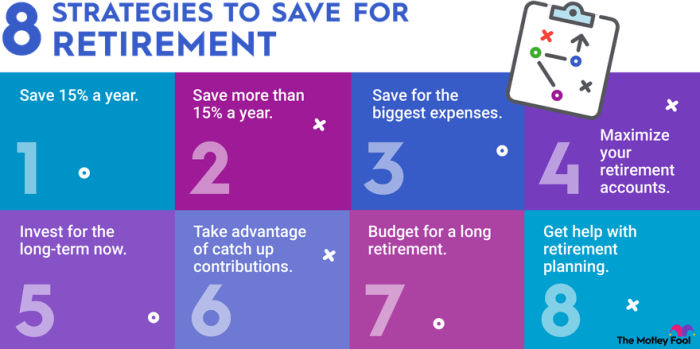Retirement investment strategies set the stage for this enthralling narrative, offering readers a glimpse into a story that is rich in detail and brimming with originality from the outset. As we dive into the world of financial planning and securing your future, we’ll explore the ins and outs of retirement investment strategies with a fresh perspective.
Overview of Retirement Investment Strategies
Investing for retirement is crucial for securing your financial future and ensuring a comfortable lifestyle once you stop working. Having a solid retirement investment strategy in place can help you build wealth over time and achieve your retirement goals.
Types of Retirement Investment Options
- 401(k): A retirement account offered by employers where you can contribute pre-tax dollars.
- IRA (Individual Retirement Account): An account that allows individuals to save for retirement with tax advantages.
- Stocks: Investing in individual stocks or stock mutual funds can provide long-term growth potential.
- Bonds: Fixed income securities that can provide a steady stream of income for retirees.
Long-term vs Short-term Retirement Investment Strategies
Long-term retirement investment strategies focus on building wealth over an extended period, usually through diversified portfolios and consistent contributions. On the other hand, short-term strategies may involve more aggressive investment approaches to generate quick returns.
Types of Retirement Investment Accounts

When it comes to planning for retirement, having the right investment accounts can make a big difference in achieving your financial goals. Let’s explore some of the most common types of retirement investment accounts and their features.
401(k) Retirement Account
A 401(k) retirement account is a employer-sponsored retirement plan that allows employees to contribute a portion of their salary on a pre-tax basis. Some key features of a 401(k) account include:
- Employer matching contributions, which can help boost your savings
- Tax-deferred growth on your investments until withdrawal
- Contribution limits set by the IRS each year
Traditional IRA vs. Roth IRA
Both Traditional and Roth IRAs are individual retirement accounts that offer tax advantages, but they have some key differences. Here’s a comparison:
- Traditional IRA:
- Contributions are typically tax-deductible
- Taxed upon withdrawal during retirement
- Required minimum distributions (RMDs) starting at age 72
- Roth IRA:
- Contributions are made with after-tax dollars
- Tax-free withdrawals in retirement (if certain conditions are met)
- No required minimum distributions during the account owner’s lifetime
Health Savings Account (HSA) as a Retirement Option
While HSAs are primarily used for medical expenses, they can also serve as a unique retirement investment option. Here are some benefits of using an HSA:
- Contributions are tax-deductible and withdrawals are tax-free for qualified medical expenses
- Unused funds can be rolled over year after year
- Once you turn 65, you can withdraw funds for any purpose penalty-free (though income tax may apply)
Diversification in Retirement Investments
When it comes to retirement investments, diversification is key. Diversification means spreading your investments across different asset classes to reduce risk and improve overall returns. By not putting all your eggs in one basket, you can protect your retirement savings from market fluctuations and unforeseen events.
Benefits of Diversifying Investments
Diversifying your retirement investments can help reduce risk in several ways:
- Different asset classes perform differently under various market conditions. By investing in a mix of stocks, bonds, real estate, and other assets, you can balance out the impact of market volatility on your portfolio.
- When one asset class is performing poorly, another may be doing well. This helps to offset losses and maintain overall portfolio growth.
- Having a diversified portfolio can provide more stable returns over the long term, potentially leading to a more secure retirement income.
Rebalancing Your Portfolio
Rebalancing involves adjusting your investment holdings to maintain your desired asset allocation.
Over time, as some investments outperform others, your portfolio may become unbalanced. Rebalancing ensures that you realign your investments to stay in line with your risk tolerance and financial goals. It’s important to periodically review and adjust your portfolio to ensure it remains diversified and aligned with your retirement objectives.
Retirement Investment Strategies for Different Stages of Life
Investing for retirement looks different depending on your age and stage of life. Let’s explore specific strategies for individuals in their 20s and 30s, how things change for those in their 40s and 50s, and tips for those nearing retirement age.
Investment Strategies for Individuals in their 20s and 30s
Young adults in their 20s and 30s have the advantage of time on their side when it comes to investing for retirement. Here are some key strategies:
- Start early and take advantage of compounding interest.
- Invest in growth-oriented assets like stocks for higher returns.
- Consider a Roth IRA for tax-free withdrawals in retirement.
- Don’t be afraid to take on some risk for potentially higher rewards.
Changes in Investment Strategies for Individuals in their 40s and 50s
As individuals move into their 40s and 50s, their investment strategies may need to shift to focus more on preservation of capital and reducing risk. Here’s how the approach can change:
- Consider shifting towards more conservative investments like bonds or dividend-paying stocks.
- Review your asset allocation and make adjustments to align with your retirement goals.
- Maximize contributions to retirement accounts to catch up if needed.
- Start thinking about retirement income strategies and how to draw down your investments.
Tips for Adjusting Investment Strategies Close to Retirement Age
As you near retirement age, it’s crucial to fine-tune your investment strategies to protect your nest egg. Here are some tips for individuals close to retirement:
- Shift towards a more conservative asset allocation to protect your savings.
- Consider guaranteed income sources like annuities for stability in retirement.
- Review and update your retirement plan to ensure it aligns with your current financial situation.
- Consult with a financial advisor to get personalized advice on your retirement investment strategy.






